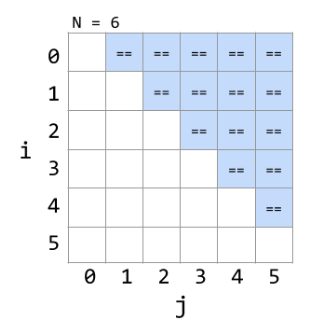Asymptotics
15.1 For Loops
int N = A.length;
for (int i = 0; i < N; i += 1)
for (int j = i + 1; j < N; j += 1)
if (A[i] == A[j])
return true;
return false;
有两种方法来渐进分析:
Methood 1: 计算运算符的数量
比如看==的执行次数,第一次循环为$N-1$次,第二次为$N-2$次,…,最后一次为$1$次,所以总共为$1+2+3+…+N-1$,即$N(N-1)/2$, 运行时间为 $\theta(N^2)$。
Methood 2: 几何分析

可以看到==的执行次数和三角形的两边 $N-1$ 都有关系,所以面积 in $N^2$ family, 可以得到运行时间为 $\theta(N^2)$
再看一个例子:
public static void printParty(int N) {
for (int i = 1; i <= N; i = i * 2) {
for (int j = 0; j < i; j += 1) {
System.out.println("hello");
int ZUG = 1 + 1;
}
}
}
执行次数为 $1+2+4+…+N$, 和为 $2N-1$
所以执行时间为 $\theta(N)$
总结两条规律:
$1+2+3+…+Q=Q(Q+1)/2=Θ(Q2)$
$1+2+4+8+…+Q=2Q−1=Θ(Q)$
15.2 Recursion
public static int f3(int n) {
if (n <= 1)
return 1;
return f3(n-1) + f3(n-1);
}
执行次数为 $1+2+4+…+2^N$, 和为 $2^N-1$
15.3 Binary Search
二分查找的时间复杂度是 $log(N)$
15.4 Mergesort
归并排序的时间复杂度是 $N * log(N)$
每一层都需要 $N$ 次排序,共有 $log_{2}N$ 层。
- The top level takes ~N AU.
- Next level takes ~N/2 + ~N/2 = ~N.
- One more level down: ~N/4 + ~N/4 + ~N/4 + ~N/4 = ~N.
Thus, total runtime is ~Nk, where k is the number of levels.
How many levels are there? We split the array until it is length 1, so k = $log_{2}N$, Thus the overall runtime is $Θ(N∗log(N))$